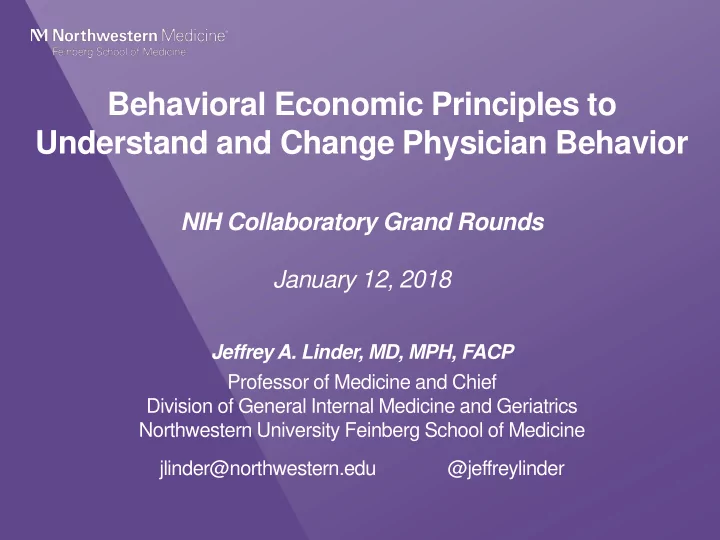

Behavioral Economic Principles to Understand and Change Physician Behavior NIH Collaboratory Grand Rounds January 12, 2018 Jeffrey A. Linder, MD, MPH, FACP Professor of Medicine and Chief Division of General Internal Medicine and Geriatrics Northwestern University Feinberg School of Medicine jlinder@northwestern.edu @jeffreylinder
Disclosures • Stock: Amgen, Biogen, and Eli Lilly • Grant Funding: AHRQ, NIA, NIDA • Former grant funding: Astellas Pharma, Inc. and Clintrex/Astra Zeneca • Honoraria: SHEA (supported by Merck)
Outline • Antibiotic prescribing • Behavioral science • Preliminary behavioral interventions • BEARI (Behavioral Economics/Acute Respiratory Infection) Trial
Background: Acute Respiratory Infections • 10% of all ambulatory visits • 44% of antibiotics • Inappropriate antibiotic prescribing Costs Antibiotic-resistant bacteria Changing the microbiome Adverse drug events
Antibiotic Prescribing in the US • N = 3153 representing 31 million visits Barnett and Linder. JAMA 2014
Antibiotic Prescribing in the US • Adults with sore throat, 1997-2010 • N = 8191 representing 92 million visits Barnett and Linder. JAMA Intern Med 2014
Antibiotic Prescribing • 506 antibiotic prescriptions per 1000 people • 30% unnecessary • 50% of ARI prescribing unnecessary • US: 833 per 1000 people • Sweden: 388 → 250 per 1000 people
Changing Behavior • Limited success of prior interventions • Implicit model: clinicians reflective, rational, and deliberate “Educate” and “remind” interventions • Behavioral model: decisions fast, automatic, influenced by emotion and social factors Use cognitive biases Appeal to clinician self-image Consider social motivation
Imbalance in Factors Related to Antibiotic Prescribing Mehrotra and Linder. JAMA Intern Med 2016
Antibiotic Prescribing by Hour of the Day Linder. JAMA Intern Med 2014
Nudges Target Automatic Thinking • Nudge: gentle, non-intrusive persuaders which influence choice in a certain direction • Different frames, default rules, feedback mechanisms, social cues • Can be ignored • A good nudge will only affect choice when there are not strong reasons for the decision • “Libertarian paternalism”
Public Commitment: Methods • Randomized 14 clinicians Stratified by high and low-prescribing • 48 week baseline • 12 week intervention • 954 non-antibiotic-appropriate ARI visits
Public Commitment: Results Control Poster 60% Antibiotic Prescribing Rate 50% 40% 30% 20% 10% 0% Baseline Intervention Adjusted difference-in-differences: -20% (-6% to -33%)
CDC funded Replications: IDPH & NYSDH CDC Core Elements Outpatient Antibiotic Stewardship (2017) EU Draft Guidelines for Antibiotic Stewardship
BEARI: The Behavioral Economics/Acute Respiratory Infection Trial
CDS and HIT often Disappoint • Electronic health records with clinical decision support Touted as a solution to problems of medical safety, cost, and quality • Many EHR/CDS implementations Do not achieve expected improvements Implicitly assume clinicians follow a standard economic/behavioral model
Specific Aim • To evaluate 3 behavioral interventions to reduce inappropriate antibiotic prescribing for acute respiratory infections 3 health systems using 3 different EHRs
Interventions 1. Suggested Alternatives 2. Accountable Justification 3. Peer Comparison
Intervention 1: Suggested Alternatives
Intervention 1: Suggested Alternatives
Intervention 1: Suggested Alternatives
Intervention 1: Suggested Alternatives
Intervention 1: Suggested Alternatives
Intervention 2: Accountable Justification Patient has asthma.
Interventions 1 and 2: Combined Patient insists on antibiotics.
Intervention 3: Peer Comparison “You are a Top Performer” You are in the top 10% of clinicians. You wrote 0 prescriptions out of 21 acute respiratory infection cases that did not warrant antibiotics. “You are not a Top Performer” Your inappropriate antibiotic prescribing rate is 15%. Top performers' rate is 0%. You wrote 3 prescriptions out of 20 acute respiratory infection cases that did not warrant antibiotics.
Interventions: Summary EHR-based Social Nudges Motivation Suggested Accountable Peer Alternatives Justification Comparison
Methods: Practices and Randomization 47 Primary Care Practices 3 Health Systems, 3 EHRs Los Angeles: 25 Boston: 22 Randomization: Blocked by Region None SA AJ PC SA PC AJ PC SA AJ PC SA AJ 18 Month Follow-Up December 2012 – April 2014
Methods: Enrollment • Invited: 355 clinicians • Enrolled: 248 (70%) Consent Education Practice-specific orientation to intervention Honorarium
Methods: Primary Outcome • Antibiotic prescribing for non-antibiotic- appropriate diagnoses Non-specific upper respiratory infections Acute bronchitis Influenza • Excluded: chronic lung disease, concomitant infection, immunosuppression • Data Sources: EHR and billing data
Methods: Analysis • Piecewise hierarchical model Clinician and practice-level clustering 18-month baseline period 18-month intervention Modeled differences in the trajectory of antibiotic prescribing starting at month zero Evaluated interactions
Results: Clinicians (N = 248) Suggested Accountable Peer Control Comparison Alternatives Justification Age, mean 47 49 48 48 % Female 48 68 61 61 Clinician Type Physician 81 79 81 80 PA or NP 19 21 19 20 Baseline Inappropriate 39 31 32 25 Antibiotic Prescribing Rate
Results: Visits (N = 16,959) Suggested Accountable Peer Control Alternatives Justification Comparison Age, mean 49 47 48 46 % Female 65 70 66 68 White 88 86 88 87 Latino 35 32 30 36 Private insurance 60 59 58 58
Main Results: Suggested Alternatives -5% p = 0.66
Main Results: Accountable Justification -7% p < .001
Main Results: Peer Comparison -5% p = <.001
Limitations Strengths • Limited to enrollees • Randomized controlled trial • Dependent on EHR • Large size and billing data • 3 different EHRs
Acknowledgements Funded by the National Institutes of Health (RC4AG039115) University of Southern California Partners HealthCare, BWH, MGH Jason N. Doctor, PhD Jeffrey Linder, MD, MPH Dana Goldman, PhD Yelena Kleyner Joel Hay, PhD Harry Reyes Nieva Richard Chesler Chelsea Bonfiglio Tara Knight Dwan Pineros University of California, Los Angeles Northwestern University Craig R. Fox, PhD Stephen Persell, MD, MPH Noah Goldstein, PhD Elisha Friesema RAND Cope Health Solutions Mark Friedberg, MD, MPP Alan Rothfeld, MD Daniella Meeker, PhD Charlene Chen Chad Pino Gloria Rodriguez Auroop Roy Hannah Valino
Persistence of Effects
Persistence: Suggested Alternatives Linder. JAMA 2017
Persistence: Accountable Justification Linder. JAMA 2017
Persistence: Peer Comparison Linder. JAMA 2017
Imbalance in Factors Related to Antibiotic Prescribing Mehrotra and Linder. JAMA Intern Med 2016
Summary: Behavioral Interventions • Doctors are people too • Doctoring is an emotional, social activity • Behavioral principles Decision fatigue Pre-commitment Accountable justifications Peer comparison
Thank You Questions? Conversation? jlinder@northwestern.edu @jeffreylinder
Recommend
More recommend